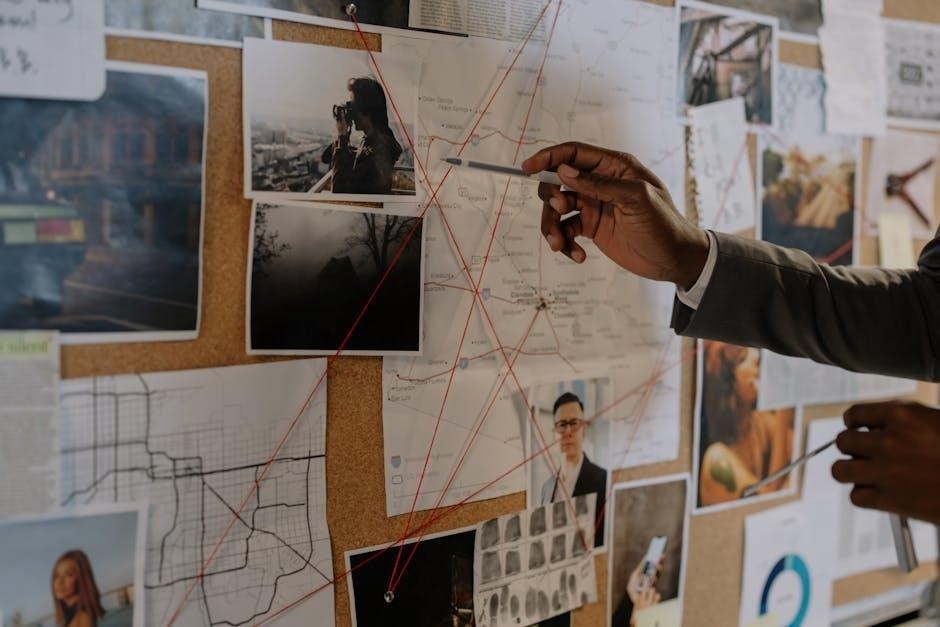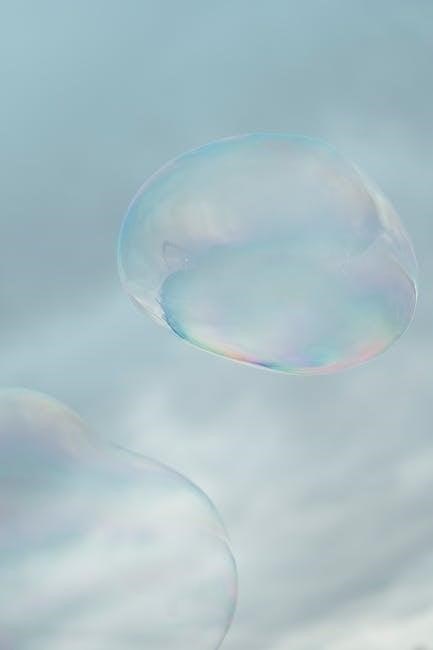A hydraulic circuit diagram is a visual representation of a hydraulic system‚ illustrating components like pumps‚ valves‚ and cylinders‚ and their interconnections. It aids in understanding system operations‚ designing circuits‚ and troubleshooting issues. These diagrams are essential for engineers to plan and analyze hydraulic systems effectively‚ often available as PDF guides for reference.
What is a Hydraulic Circuit Diagram?
A hydraulic circuit diagram is a detailed visual representation of a hydraulic system‚ showcasing its components‚ connections‚ and the flow of hydraulic fluid. It uses standardized symbols to depict elements like pumps‚ valves‚ cylinders‚ and actuators. The diagram illustrates how these components interact to achieve specific functions‚ such as lifting‚ clamping‚ or pushing. It serves as a blueprint for designing‚ analyzing‚ and troubleshooting hydraulic systems‚ ensuring efficiency and safety in operation. Engineers rely on these diagrams to plan and optimize system performance.
Importance of Hydraulic Circuit Diagrams in System Design
Hydraulic circuit diagrams are essential for designing efficient and reliable hydraulic systems. They provide a clear visual representation of component interactions‚ enabling engineers to plan and troubleshoot effectively. These diagrams ensure proper fluid flow‚ pressure control‚ and system safety. They also standardize communication among designers‚ manufacturers‚ and technicians‚ reducing errors and enhancing collaboration. A well-designed hydraulic circuit diagram is crucial for optimizing performance‚ reducing costs‚ and ensuring the system meets operational requirements.

Basic Components of Hydraulic Systems
Hydraulic systems rely on key components such as pumps‚ motors‚ cylinders‚ valves‚ reservoirs‚ and filters. These essential elements work together to control fluid flow and pressure‚ as shown in circuit diagrams.
Primary Components: Pumps‚ Motors‚ and Cylinders
Pumps are the heart of hydraulic systems‚ converting electrical energy into hydraulic energy. Motors transform hydraulic energy back into mechanical energy‚ while cylinders provide linear motion. These components are essential for system operation‚ with pumps delivering fluid under pressure‚ motors driving machinery‚ and cylinders executing tasks like lifting or clamping. Their proper functioning ensures efficient energy transfer and precise control in hydraulic circuits.
Valves and Their Functions in Hydraulic Circuits
Valves regulate fluid flow‚ pressure‚ and direction in hydraulic circuits. They control the system’s operation by opening‚ closing‚ or modulating pathways. Types include directional‚ pressure‚ and flow control valves‚ each serving specific roles like redirecting fluid flow or maintaining system pressure. Proper valve function ensures efficient operation‚ safety‚ and precision in hydraulic systems‚ making them crucial for achieving desired performance and reliability.
Reservoirs‚ Filters‚ and Accumulators
Reservoirs store hydraulic fluid‚ ensuring consistent supply and cooling. Filters remove contaminants‚ preventing system damage. Accumulators store energy kinetically‚ smoothing flow fluctuations and providing emergency power. Together‚ these components maintain system efficiency‚ stability‚ and cleanliness‚ crucial for reliable operation and longevity of hydraulic circuits.
Actuators and Their Role in Hydraulic Systems
Actuators‚ such as hydraulic cylinders and motors‚ convert hydraulic energy into mechanical energy‚ enabling movement and force application. They execute tasks like lifting‚ pushing‚ or rotating loads‚ serving as the final components in a hydraulic circuit. Actuators are crucial for achieving the desired system functionality‚ ensuring precise control and efficient energy transfer to perform mechanical work in various applications.

Understanding Hydraulic Circuit Symbols
Hydraulic circuit symbols represent components and connections in a hydraulic system. Standardized symbols ensure clarity and consistency in designing and interpreting hydraulic circuit diagrams effectively.
Standard Symbols for Hydraulic Components
Standard symbols for hydraulic components are essential for creating clear and consistent hydraulic circuit diagrams. These symbols represent elements like pumps‚ valves‚ cylinders‚ reservoirs‚ and accumulators. Each symbol is standardized to ensure universal understanding. For example‚ a pump is often depicted as a circle with an arrow indicating flow direction‚ while valves are shown as rectangles with lines representing ports and flow paths. These symbols help engineers design‚ analyze‚ and troubleshoot hydraulic systems efficiently.
Interpreting Lines and Connections in Diagrams
Lines and connections in hydraulic circuit diagrams represent fluid flow paths and system interactions. Solid lines indicate hydraulic fluid flow‚ while dashed lines often denote pilot or control lines. Arrows show flow direction‚ and intersections without circles mean lines are connected. Color coding may differentiate between high-pressure‚ low-pressure‚ and drain lines‚ aiding in system understanding and ensuring proper installation and operation of hydraulic components.

Types of Hydraulic Circuits
Hydraulic circuits are categorized into open-loop and closed-loop systems. Open-loop circuits circulate fluid from a pump to an actuator and back to a reservoir. Closed-loop systems recirculate fluid within the system‚ enhancing precision and efficiency for advanced applications.
Open-Circuit Hydraulic Systems
Open-circuit hydraulic systems circulate fluid from a pump to an actuator and back to a reservoir. They are commonly used in industrial machinery‚ offering simplicity and cost-effectiveness. These systems rely on a reservoir for fluid storage and typically use pressure relief valves to regulate system pressure. Open-circuit designs are ideal for applications where precise control is not critical‚ providing reliable operation in various hydraulic applications.
Closed-Loop Hydraulic Systems
Closed-loop hydraulic systems continuously circulate fluid between a pump and an actuator without returning to a reservoir. These systems are designed for high-precision applications‚ such as CNC machines and robotics. They often incorporate proportional and servo valves to regulate flow and pressure accurately. Closed-loop systems provide superior control‚ enabling precise positioning and consistent performance‚ making them essential for advanced hydraulic applications requiring high accuracy and fast response times.

Designing a Basic Hydraulic Circuit
Designing a basic hydraulic circuit involves knowing symbols‚ selecting components‚ and understanding flow and pressure requirements to create an efficient system‚ guided by a hydraulic circuit diagram PDF.
Steps to Create a Hydraulic Circuit Diagram
Creating a hydraulic circuit diagram begins with identifying system requirements‚ such as load and application. Select components like pumps‚ valves‚ and cylinders. Sketch the diagram using standardized symbols‚ ensuring clarity. Define flow paths and connections‚ specifying pressure and flow rates. Label each component for easy identification. Finally‚ review and validate the diagram for accuracy and functionality to ensure it meets design goals. This structured approach guarantees a clear and effective hydraulic system representation.
Component Selection and Sizing
Selecting and sizing components for a hydraulic circuit involves determining the right pumps‚ valves‚ cylinders‚ and actuators based on load‚ pressure‚ and flow requirements. Engineers analyze system demands‚ such as lifting capacity and operational speed‚ to choose appropriate sizes. Manufacturer specifications and industry standards guide the selection process. Proper sizing ensures efficient performance‚ minimizes energy loss‚ and guarantees reliable operation under varying conditions. Accurate component selection is critical for system functionality and longevity.
Flow and Pressure Analysis
Flow and pressure analysis ensures hydraulic systems operate within safe and efficient parameters. By calculating flow rates and pressures at each component‚ engineers can identify potential bottlenecks and optimize performance. This involves measuring pressure drops‚ fluid velocity‚ and system resistance. Accurate analysis prevents overloading‚ reduces energy losses‚ and ensures smooth operation. Tools like pressure gauges and flow meters aid in verifying system performance‚ while simulations help predict behavior under various conditions for reliable circuit design.
Applications of Hydraulic Circuit Diagrams
Hydraulic circuit diagrams are essential in designing industrial machinery‚ aerospace systems‚ and heavy equipment‚ ensuring efficient fluid power transmission and precise system control across various industries.
Industrial Machinery and Automation
Hydraulic circuit diagrams are integral to industrial machinery‚ facilitating the design and operation of systems like manufacturing equipment‚ material handling‚ and automated production lines. These diagrams detail the flow of hydraulic fluid‚ ensuring precise control over actuators‚ pumps‚ and valves. They enable engineers to optimize performance‚ predict behavior under varying loads‚ and maintain safety standards in high-pressure industrial environments. This visualization is crucial for troubleshooting and enhancing overall system efficiency.
Aerospace and Defense Applications
Hydraulic circuit diagrams play a critical role in aerospace and defense systems‚ where precision and reliability are paramount. They are used to design and analyze systems for aircraft‚ missiles‚ and military equipment‚ ensuring optimal performance under extreme conditions. These diagrams help engineers manage complex hydraulic networks‚ enabling accurate control of actuators‚ valves‚ and pumps. They are essential for maintaining the safety and operational integrity of advanced defense and aerospace technologies.
Construction and Heavy Machinery
Hydraulic circuit diagrams are indispensable in construction and heavy machinery‚ enabling the design and operation of equipment like excavators‚ cranes‚ and bulldozers. These diagrams illustrate the flow of hydraulic fluid‚ ensuring efficient operation of actuators‚ motors‚ and valves. They help technicians troubleshoot issues and optimize system performance‚ making them crucial for maintaining productivity and safety in demanding environments where precise hydraulic control is essential for heavy-duty tasks and machinery operation.

Reading and Interpreting Hydraulic Diagrams
Reading hydraulic diagrams involves understanding symbols‚ connections‚ and system layouts. This skill is crucial for troubleshooting‚ maintenance‚ and optimizing hydraulic systems effectively.
Understanding the Layout and Structure
Hydraulic circuit diagrams are structured to visually represent components and their connections. Standard symbols denote pumps‚ valves‚ and actuators‚ while lines indicate fluid flow paths. Color coding and line types differentiate between pressure‚ return‚ and control lines. The layout helps identify system hierarchy‚ making it easier to trace fluid flow and understand how components interact. This structure is essential for diagnosing issues and optimizing system performance.
Identifying Components and Their Functions
In hydraulic diagrams‚ components are represented by standardized symbols‚ each indicating a specific function. Pumps are shown as circles with internal lines‚ while valves are depicted with arrows and boxes. Cylinders and motors are symbolized by rectangles with lines‚ representing movement. Filters‚ reservoirs‚ and accumulators have distinct shapes‚ aiding in quick identification. Understanding these symbols allows engineers to decode system functionality‚ ensuring accurate interpretations and effective troubleshooting.

Tools for Creating Hydraulic Circuit Diagrams
Specialized software like AutoCAD and hydraulic system design tools enable precise creation of circuit diagrams. Online templates and resources also provide pre-designed symbols and layouts for customization;
Software for Hydraulic System Design
Software tools like AutoCAD‚ SolidWorks‚ and specialized hydraulic design programs offer advanced features for creating detailed circuit diagrams. These programs provide libraries of hydraulic symbols‚ simulation capabilities‚ and analysis tools to optimize system performance. They enable engineers to design‚ test‚ and refine hydraulic circuits efficiently‚ ensuring accuracy and functionality. Additionally‚ they support the creation of PDF documentation for easy sharing and reference.
Online Resources and Templates
Various online platforms offer downloadable hydraulic circuit diagram templates in PDF format‚ simplifying the design process. Websites provide tutorials‚ symbol libraries‚ and pre-designed layouts for pumps‚ valves‚ and actuators. Engineers can access these resources to create accurate diagrams‚ ensuring compliance with industry standards. These templates are customizable‚ enabling quick modifications to suit specific system requirements and enhance productivity in hydraulic system design and documentation.
Safety Considerations in Hydraulic Systems
Ensure pressure and flow control to prevent system overload. Implement emergency shutdown procedures and regular maintenance. Adhere to safety standards to minimize risks and guarantee reliable operation.
Pressure and Flow Control Safety
Pressure and flow control are critical for safe hydraulic system operation. Use flow-control valves to regulate fluid movement‚ ensuring system stability. Excessive pressure can lead to component failure‚ while uncontrolled flow may cause instability. Implement pressure relief valves to prevent over-pressurization and ensure emergency shutdown procedures are in place. Regular maintenance and adherence to safety standards are essential to prevent accidents and guarantee reliable system performance. Proper control measures safeguard both equipment and operators.
Emergency Shutdown Procedures
Emergency shutdown procedures are vital for safely deactivating hydraulic systems during failures or hazards. These protocols often involve cutting off power supplies and activating fail-safe mechanisms. Hydraulic circuits typically include emergency stop buttons and pressure relief valves to halt operations swiftly. Properly designed systems ensure minimal damage and risk during shutdowns. Regular training and drills are essential to ensure operators can execute these procedures effectively‚ maintaining workplace safety and system integrity. Timely action prevents potential disasters and protects personnel.

Troubleshooting Hydraulic Circuits
Troubleshooting hydraulic circuits involves using diagrams to identify issues‚ such as leaks or valve failures. Regular maintenance and systematic checks ensure optimal system performance and reliability.
Common Issues and Diagnostic Techniques
Common issues in hydraulic circuits include leaks‚ overheating‚ and pressure drops. Diagnostic techniques involve inspecting components like pumps and valves for wear. Using circuit diagrams‚ technicians can trace faults systematically. Pressure testing and flow analysis help identify blockages or faulty valves. Regular maintenance‚ such as filter cleaning‚ prevents system failures. Understanding these diagnostic methods ensures efficient troubleshooting and minimizes downtime in hydraulic systems.
Using Diagrams for Fault Identification
Hydraulic circuit diagrams are essential for identifying faults in systems. By analyzing the diagram‚ technicians can trace issues like leaks or blockages. Understanding component symbols and connections helps pinpoint faulty elements. Pressure drops or flow inconsistencies can be visually tracked. Diagrams also guide maintenance‚ ensuring timely repairs. This systematic approach reduces downtime and enhances system reliability‚ making diagrams indispensable for effective fault identification and resolution.

Advanced Hydraulic Circuit Concepts
Advanced hydraulic circuits incorporate servo-control systems and proportional valves for precision control. These systems enhance performance in applications like aerospace and industrial automation‚ improving efficiency and accuracy significantly.
Servo-Controlled Hydraulic Systems
Servo-controlled hydraulic systems use servo valves to precisely regulate fluid flow and pressure. These systems provide high accuracy and fast response times‚ making them ideal for applications requiring precise control‚ such as robotics and CNC machines. They often integrate advanced feedback mechanisms to ensure optimal performance and adaptability in dynamic operating conditions. This technology enhances efficiency and reduces operational errors significantly.
Proportional and Servo Valves
Proportional and servo valves are critical components in hydraulic systems‚ offering precise control over flow and pressure. Proportional valves adjust output proportionally to input signals‚ while servo valves provide high-precision control through feedback mechanisms. Both are essential for advanced hydraulic applications‚ enabling smooth operation and efficient system performance. These valves are often represented in hydraulic circuit diagrams with specific symbols‚ ensuring clarity in system design and functionality.

Best Practices for Hydraulic Circuit Design
Adopting best practices in hydraulic circuit design ensures efficiency‚ safety‚ and reliability. Use standardized symbols‚ optimize component sizing‚ and prioritize fluid flow analysis. Regular maintenance and clear documentation are crucial for long-term performance and troubleshooting‚ as outlined in PDF guides. These practices minimize errors and enhance system durability‚ ensuring optimal functionality across various applications. Always follow industry standards to achieve superior design outcomes.
Efficiency and Performance Optimization
Optimizing hydraulic circuit efficiency involves selecting the right components and ensuring proper fluid flow. Use diagrams to identify energy-loss areas and improve system performance. Analyze pressure drops‚ flow rates‚ and valve configurations to maximize productivity. Regular maintenance and component sizing are critical. PDF guides provide detailed strategies for minimizing energy waste and enhancing system reliability. By streamlining the circuit‚ you can achieve higher operational efficiency and reduce overall costs. Always prioritize energy-efficient designs for sustainable performance.
Labeling and Documentation Standards
Clear labeling and proper documentation are essential for hydraulic circuit diagrams. Standard symbols and notation ensure consistency and readability. Each component‚ such as pumps‚ valves‚ and actuators‚ should be accurately labeled with their functions. Flow directions‚ pressure ratings‚ and connections must be clearly indicated. Adhering to established standards like ISO symbols ensures universal understanding. Proper documentation aids in maintenance‚ troubleshooting‚ and system modification‚ making it a critical aspect of hydraulic circuit design and operation.
Hydraulic circuit diagrams are essential tools for understanding‚ designing‚ and troubleshooting hydraulic systems. They provide a clear‚ standardized visual representation of components and their interactions‚ ensuring efficiency and safety in operations. Properly created diagrams‚ using standard symbols and notation‚ are vital for effective communication and maintenance in hydraulic engineering.
Hydraulic circuit diagrams are essential for understanding and designing hydraulic systems‚ providing a visual representation of components and their interactions. These diagrams use standardized symbols to depict pumps‚ valves‚ cylinders‚ and connections‚ enabling engineers to analyze flow‚ pressure‚ and system performance. They are crucial for troubleshooting and optimizing hydraulic systems‚ ensuring efficient and safe operations. Proper interpretation of these diagrams is vital for maintaining and improving hydraulic machinery in various industrial applications.
Future Trends in Hydraulic System Design
Future hydraulic systems will focus on energy efficiency‚ digitalization‚ and integration with IoT. Servo-controlled systems and proportional valves will enhance precision and responsiveness. Simulation tools will aid in optimizing designs. Eco-friendly designs‚ miniaturization‚ and smarter pumps are emerging trends. Predictive maintenance via IoT will reduce downtime. Energy recovery systems will improve sustainability. These advancements aim to create cleaner‚ more efficient hydraulic systems for industrial and mobile applications‚ aligning with global sustainability goals.
